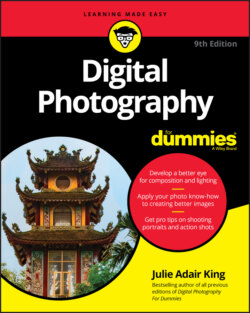Читать книгу Digital Photography For Dummies - King Julie Adair, Julie Adair King - Страница 25
Lens focal length
ОглавлениеFocal length, stated in millimeters, refers to the distance from the center of the lens to the image sensor.
Now that I’ve done my due diligence in the technical explanation department, allow me to explain focal length in practical terms:
Focal length determines the lens’s angle of view. The shorter the focal length, the more subject area fits in the frame. Increasing focal length narrows the angle of view and makes your subject appear closer and larger. Figure 1-8 illustrates this fact, showing the same scene captured at four focal lengths. (A lower number indicates a shorter focal length.)Some focal length recommendations:Landscape photography: Look for a wide-angle lens, characterized by a focal length of 35mm or shorter.Nature and sports photography: Assuming you'll be shooting at a fair distance from your subject, you need a telephoto lens, which has a focal length of 70mm or longer.Portrait photography: Aim for a focal length in the range of 70–135mm. At other focal lengths, facial features can be distorted. A wide-angle lens, for example, can make your subjects appear sort of like how they look when you view them through a security peephole in a door. And a very long lens can flatten and widen a face.FIGURE 1-8: The shorter the focal length, the wider the angle of view.
Focal length affects depth of field. As focal length goes up, depth of field — the distance over which focus appears sharp — goes down. As an example, compare the backgrounds in Figure 1-8. Notice how much blurrier the trunk of the palm tree behind the sculpture appears in the 170mm image than in the versions shot at the shorter focal lengths.
The angle of view produced by any focal length depends on the camera’s crop factor. For reasons too wonky to get into, the photo industry still measures lens focal lengths using the traditional 35mm film negative as a standard. That means that you get the stated focal length — and resulting angle of view — only on a camera that has a full-frame sensor (one that's the same size as a 35mm film negative). With a camera that has a smaller sensor, the angle of view is reduced because the sensor is no longer large enough to capture the entire area that the lens can see. The resulting picture is what you would get if you took a picture with a full-frame camera and then cropped the picture. The measurement of how much frame area you lose is known as the crop factor.Because sensor sizes vary, the crop factor depends on the camera model. Most dSLR and mirrorless image sensors have a crop factor ranging from 1.5 to 2. Figure 1-9 illustrates the image area at these crop factors when compared to the full-frame view.To figure out what angle of view a lens will provide, multiply the lens focal length by the camera’s crop factor, which should be stated in the camera specs. For example, if the camera has a crop factor of 1.5, a 50mm lens gives you the same angle of view as a 75mm lens on a full-frame digital or 35mm-film camera.
FIGURE 1-9: The white, red, and blue boxes indicate the angle of view you get with cameras that have crop factors of 1.5, 1.6, and 2.0, respectively.
In most cases, focal length is printed on the lens, but for some models, you may need to check the user manual or lens spec sheet. Often, the manufacturer gives both the actual focal length of the lens (that's the measurement mentioned in the opening to this section) as well as the 35mm equivalent.
